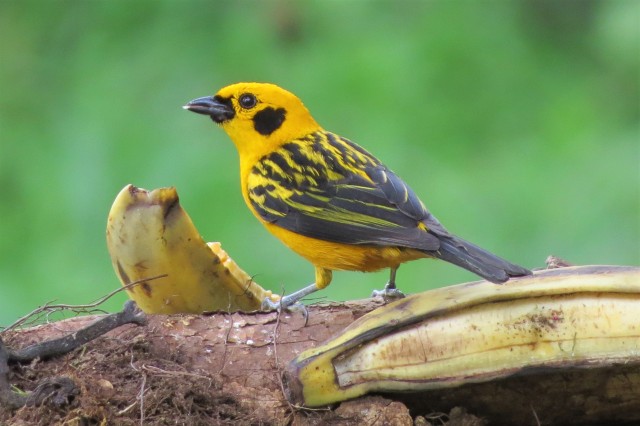
Most birders visit Ecuador as part of an organized tour, and most of the online trip reports are either from tour guide leaders or their clients. There is nothing wrong with that – a lot of this information is very good. However, there are far fewer resources available for those who want to “go it alone” and bird Ecuador independently, so I hope that this report is especially useful for those who don’t want to shell out the big bucks for a tour.
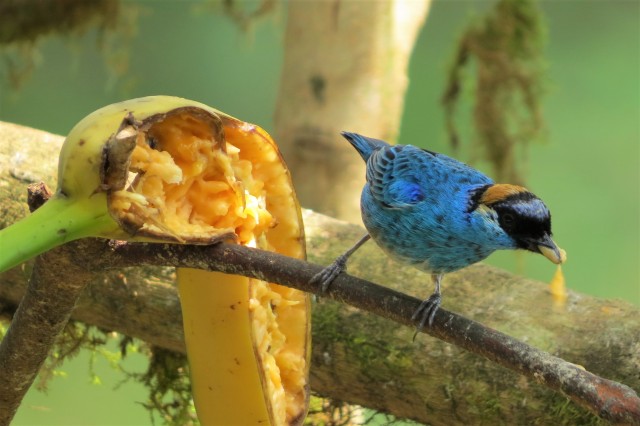
The difficult part of birding Ecuador is not the infrastructure, nor the travel logistics. The area around which I centered my trip – the Mindo Valley – lies within easy reach of the international airport in Quito. The main roads are smooth and well-engineered, and (I am told) much improved in recent years. Even the dirt roads – while rough and steep in places – can be tackled in a regular two-wheel-drive car. Accommodation is plentiful and inexpensive. Nothing about Ecuador would pose a problem for anyone with prior overseas independent birding experience – it is a good deal less challenging than many Asian destinations, for example.

However, speaking as someone who has birded in 56 countries – and with some fairly serious international birding trips under my belt – take it from me that nowhere have I more acutely felt the lack of a local, knowledgeable guide than in Ecuador. Let me explain. Cloud forests are not easy places to bird – the trees are high, and the weather is regularly gloomy and misty. Add to that a huge and staggeringly diverse avifauna, and enormous mixed flocks that pass quickly through at treetop height, and you can start to understand how frustrating the birding experience can be in Ecuador – even for someone with broad experience in a number of other nearby countries (I’ve birded Costa Rica, Panama, and Honduras fairly extensively so I am familiar with many of the Neotropical bird families).
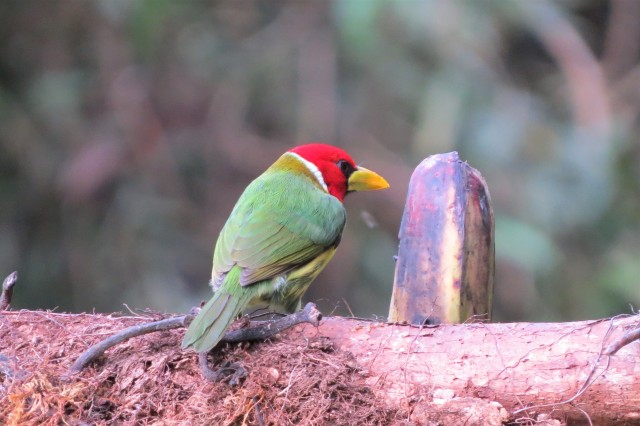
For the first couple of days, I was identifying barely a handful of species in each mixed flock, and at times it felt like I was spending more time leafing through my field guide than watching the birds! My advice to the independent birder would be to buy a field guide well in advance of your trip, and spend a lot of time reading the guide and trying to nail down the ID of species you are likely to encounter. And even if you do that, you will probably still feel completely out of your depth for several days.
On the other hand, many of the reserves and lodges maintain feeding stations with as many as 12-15 hummingbird species buzzing around, and colorful tanagers coming down to feed at eye level and close range. Spending time at these feeding stations is a good way to build familiarity with some of the more commonly seen species.
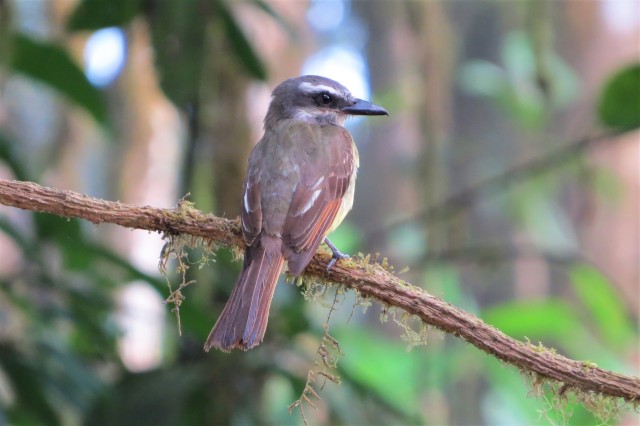
The trip logistics were as follows:
Planning: I purchased the bang-up-to-date “Birds of Ecuador” field guide, recently published by Helm. This is a very comprehensive and portable guide to all the birds recorded in Ecuador – some 1,630 species. A Kindle edition of this guide is available, but I much prefer the “old school” paper version to take into the field.
While I was satisfied with the guide overall, I have a few reservations. First, having a guide that covers the entire country brings some confusion to the mix for a first-time Ecuador birder who is covering just a small area. If you can find a more localized guide to the birds of northwest Ecuador, this would provide a useful supplement to the Helm guide.
Second, some of the bird illustrations in the Helm guide didn’t seem accurate to me. This was a problem on several occasions, when I had great looks at what I figured would be an easy bird to identify – and then couldn’t find it anywhere in the guide. I had to resort to online images to get to the bottom of several IDs of birds which to my eye were inaccurately illustrated. I found this to be true of several flycatchers in particular. Admittedly part of this is due to my lack of skill with Ecuadorian birds, but I feel that the field guide must bear some of the blame too.
As well as reading the Helm guide, and researching online trip reports, I also spent a while on eBird checking out different hotspots in the areas I was planning to visit. A good way to form an itinerary would be to combine information from trip reports with the latest reports from eBird to help target any particular species.

Flight: I live in Houston so there are plentiful flights to South America. Direct flights on United from Houston to Quito take only about 5 hours, but they arrive in the middle of the night, and I didn’t want to turn up at night in an unfamiliar country. With hindsight, and knowing how easy it was, I would not have had a problem turning up at night, renting a car and driving off down the road.
I found a flight with AeroMexico via Mexico City which was not only considerably cheaper than the United flight (about $550 vs. $720, round trip), but also arrived in Quito at around 6.00am – perfect timing, or so I thought, to get there in daylight, grab a rental car, hit the road, and be at the Yanacocha Reserve while it was still early enough for some great birding. More on how that turned out later!

Car rental: I had been wondering about whether to rent a car, or whether to take a bus from the airport to Mindo, base myself there, and travel out by taxi to the various birding lodges and reserves in the area.
A quick trawl through the internet reveals the usual horror stories of renting a car – a lot of the advice seems to come down to “don’t do it!”. But the seasoned driver has nothing to fear from car rental in Ecuador, and I am very glad I decided to go ahead and rent a car for the greater flexibility, convenience, and – over the course of the week – much lower costs compared to taking taxis.
Avis seemed to have the least bad reviews of a bad bunch at the airport. I found their service to be very good. In common with many developing countries, they go over the car with a fine tooth comb when you pick it up, and note down every small scratch. I didn’t damage my car, so I didn’t find out what would happen if they had found a new scratch when I returned it!
Note that most Ecuadorian rental cars are manual (“stick shift” to Americans). You should assume you will be given a manual car unless you specifically book an automatic. With the steep roads and long mountain passes, a manual is by far the best choice anyway, assuming you are able to drive one.
Another feature of Ecuadorian car rental is that many rental contracts specify a daily kilometer limit – usually 100km per day. I was given the option at the rental desk to upgrade to unlimited km for an additional $11 per day, which I declined. Northwest Ecuador is compact, and although driving times can sometimes be long on slow roads, distances are not far. As it turned out I did go slightly over my allocated mileage for the week. The charge was $0.25 for each excess kilometer, and in the end I paid an extra $20 in total, a lot less than the upgrade to unlimited kilometers would have cost.
I had pre-booked the cheapest possible car, a tiny Chevrolet Spark 1.0, via an online consolidator for around $180 in total for the 8 days. I reserved and paid for the car using my Chase Mileage Plus credit card because it includes CDW and LDW insurance as primary coverage. Not many credit cards have this feature, so this one is an excellent option for overseas car rentals. I did, however, opt to add the maximum liability insurance coverage at the rental desk, making the total cost of my rental around $260.
At the rental desk, I was offered the chance to upgrade my tiny vehicle to a more robust and powerful one. The difference in price didn’t seem worth it, and I am glad I stuck with my Spark – although it was a little under-powered on the long mountain passes, it handled all kinds of rough dirt roads and steep slopes without any issues. If I was traveling with a companion or an extra suitcase, it may have been a different story.
Gas (petrol) in Ecuador is very cheap – even less than the US – and my tiny car hardly used any of it, I spent a total of about $35 on gas for my whole visit. Compared to the US, there are few gas stations – for example after leaving the outskirts of Quito on the E20, heading over the Papallacta pass, there is no gas for 86km until you reach Baeza, so make sure you fill up whenever you can.
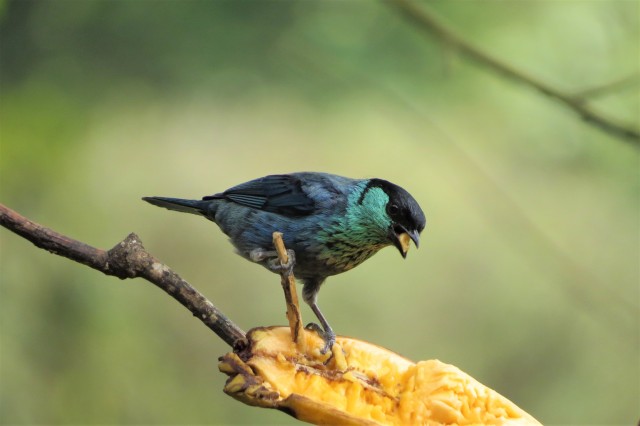
Driving: All the main roads I encountered were smooth, well-graded, and lightly trafficked. The highway from the airport to Quito, and the long pass to Papallacta, are particularly excellent. The back roads vary in quality, many are all-weather dirt roads but all the ones I used were all passable in my Chevrolet Spark.
Accommodation: I had booked Sachatamia Lodge in advance for the first two nights of my trip, to ease me into Ecuador and give me a comfortable place to aim at from the airport. For nights 3-6, I moved into a cheaper private room in Cinnamon House, an excellent hostel in Mindo town. Night 7 was spent in Papallacta, and the final night in an airport hotel ready for my early morning flight the next day.
I reserved all of the above places on Booking.com, and none of them required prepayment – it was a “cash on arrival” kind of deal. There is a large range of accommodation options, especially in the Mindo area – everything from upmarket luxury lodges to hostel dorms, and the independent traveler is unlikely to encounter any problems finding somewhere to stay.
Sachatamia Lodge: A well-located, comfortable lodge situated just off the main Quito to San Miguel de los Bancos road, close to the Mindo turn-off. Being at the top of the hill above Mindo, it had a noticeably different avifauna compared to Mindo town. This lodge has several trails, excellent feeding stations for tanagers and hummingbirds, and even a blind overlooking a moth trap which was interesting for forest species in the early mornings when they came to eat the moths.
My comfortable room was $65 per night, putting Sachatamia Lodge firmly at the low-budget end of the spectrum for out-of-town bird lodges. A very good breakfast was included, and the dinner menu had plenty of variety and was priced at around $11-$18 for a main course.
Cinnamon House: A basic but clean and comfortable private room, with private bathroom and balcony, was $25 per night. This is a super-friendly hostel geared up to the younger, solo traveler. There is a kitchen so you can self-cater, although the grocery stores in Mindo town stock only the basics.
El Fogon Campero: This budget hotel is on the road to the hot springs in Papallacta. I had prebooked on Booking.com but they seemed surprised when I turned up, and no one else was staying there. My final bill for room and dinner was $26. Nights are cold at this altitude, but my room was well-equipped with blankets and a space heater.
Hostal Mariscal Sucre: This hotel is very close to the airport and costs $25 a night. I wasn’t given a key when I checked in, and when I asked at reception they couldn’t find one for my room, so I had to leave the room unlocked when I went out to dinner. I guess they are used to people just turning up, crashing for the night, and leaving the next morning without needing a key. It was a perfectly functional night halt although there is nowhere to eat in the evening within walking distance (but a very good Italian-owned pizza restaurant is a short drive away).

Food: Sometimes I had lunch if it fitted in with birding (for example at Mirador Rio Blanco in San Miguel de los Bancos, where I could eat while watching Rufous-throated Tanagers at the feeders). Otherwise, I subsisted during the day on protein bars, trail mix, apples, and boiled eggs, some of which I brought from home. Coffee is widely available.
Mindo town has a reasonable choice of restaurants for dinner, I particularly recommend the Dragonfly Inn just next to the bridge as you come into town. If I find somewhere I like, I tend to eat there for every meal, purely for convenience – this was after all a birding and not a gastronomic trip.
Money: Ecuador uses the US Dollar as its currency, but with more coins – they have a 50 cent coin, and $1 coins typically replace dollar bills here. I took about $500 in cash in a variety of bills with me. There are also ATMs available in towns which accept foreign credit and debit cards.
Weather: This is a cloud forest region and the weather is unpredictable. The main enemies of the birder are fog and low cloud, which occurred frequently during my trip especially in the afternoons, and of course rain. Persistent rain was only really a problem on one day of my trip, with occasional showers at other times. Bird activity was noticeably higher on cloudy days versus sunny ones. Up at 13,000+ feet ASL at the Papallacta Pass, you can expect the default weather conditions to be cold, foggy, and drizzly, even in the early mornings.
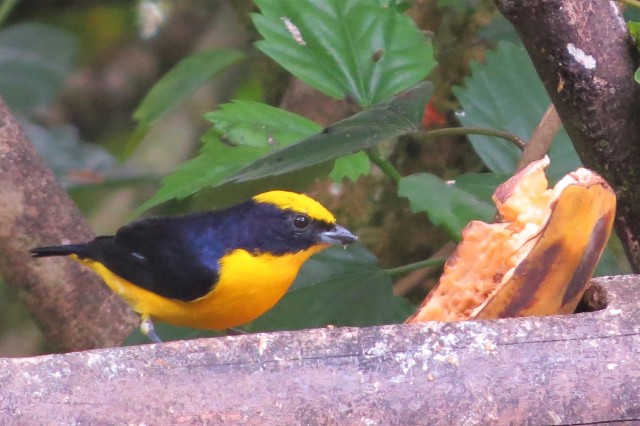
Itinerary: I had a broad plan to follow a tour company’s itinerary for the Mindo area which I had found online, making small tweaks based on the fact that I was staying in a different lodge to them. But I didn’t stick to my plan, and instead ended up using it as a “rough guide” to the best places to visit for the widest variety of birds. Be prepared to change course at short notice and be flexible due to weather conditions. On several afternoons, I ended up at the (very birdy) Yellow House Trails in Mindo when rain and fog had closed in on the surrounding hills.
Daily Overview:
Saturday 21st September Morning: Drive from airport via the old Mindo “Eco Ruta” and Alambi Lodge. Afternoon: Sachatamia Lodge.
Sunday 22nd September Morning: Sachatamia Lodge then Mindo village area. Afternoon: Sachatamia Lodge.
Monday 23rd September Morning: Sachatamia Lodge. Afternoon: Mindo Yellow House Trails.
Tuesday 24th September Morning: Rio Silanche then Mirador Rio Blanco for lunch. Afternoon: Mindo Yellow House Trails.
Wednesday 25th September Morning: Refugio Paz de las Aves. Afternoon: Milpe Bird Sanctuary.
Thursday 26th September All day: Rio Silanche.
Friday 27th September Morning: Old Mindo Road (Eco Ruta) then Yanacocha Reserve. Afternoon: Drive to Papallacta.
Saturday 28th September Morning: Papallacta Pass, then Papallacta village area. Afternoon: Guango Lodge and Laguna Papallacta.

DAY ONE – Saturday 21st September: My flight arrived on time and the staff at the Avis rental desk were friendly and efficient. I was soon on the road towards Quito. Google maps served me pretty well getting me through the city and out into the hills on the other side, but unfortunately at that point it let me down.
Despite being near Quito, the Yanacocha Reserve is located in quite a remote area, and although the map appears to indicate three different ways to get there, there is in fact only one possible route from Quito. At first, Google took me up a private road to a hacienda, and my second attempt – approaching from the village of Nono – ended at a locked gate. I had somehow missed the sign at this spot: Google Maps Link. If you turn left (south) at this concealed turning, you should pick up signs all the way to the Yanacocha Reserve. The roads are pretty rough but passable with care in an ordinary car.
Having failed twice to get to Yanacocha, and with the best of the morning’s birding hours already behind me, I decided to press on towards Mindo via the “Eco Ruta” – the old Mindo road which gradually descends in altitude and eventually joins the main highway 28 near Tandayapa. This is a dirt road and takes an eternity to drive along. I stopped here and there, but the only notable bird was a Rufous-chested Tanager, my only one of the trip.
I got my first taste of some “feeder action” at the Alambi Cloud Forest Lodge, where I spent a couple of hours getting to grips with some of the more regular hummingbirds and tanagers. I saw nothing here that I didn’t commonly see elsewhere during the week, but it was a nice introduction to Mindoese bird life. Next door to the feeding station, a trout fishery and restaurant provided an excellent lunch stop and I was invited to eat with a father and son who had spent the morning fishing there – my first taste of Ecuadorian friendliness, hospitality – and of course, trout.
I found Sachatamia Lodge very easily thanks to a brand new sign along the highway. The weather was foggy and drizzly. A staff member named Johnny, who is a keen wannabe bird guide learning his trade, offered to show me a pair of roosting Crested Owls for $10, an offer I could hardly refuse! The rest of the afternoon was spent getting frustrated trying and failing to identify bird silhouettes in the gloom, but at least the hummingbird feeders at the lodge were busy with a nice variety of hummers of about 15 species including Booted Racket-tail, Purple-bibbed Whitetip, Purple-throated Woodstar, Velvet-purple Coronet, and numbers of Violet-tailed Sylph.
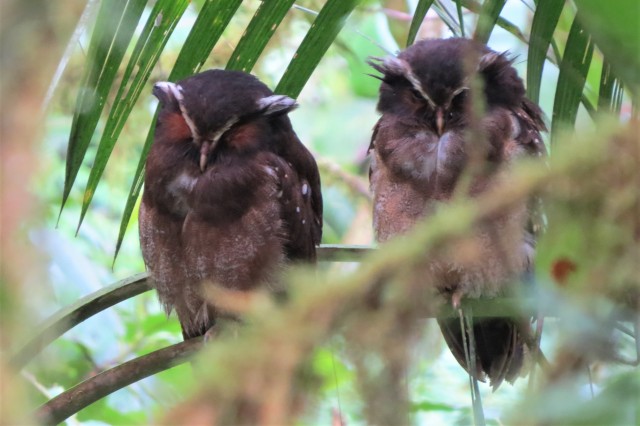
DAY TWO – Sunday 22nd September: I met with Johnny, and another couple of birders, at 6.00am outside the lodge, and a few minutes later we were seated in a hide overlooking a moth trap. Overnight, powerful lights are shone on a white tarpaulin, to which large numbers of moths are attracted. This is an excellent place to start the day as, even before it gets properly light, various forest-dwelling birds hang out there to enjoy a tasty moth breakfast.
Birds seen from this blind today and on subsequent mornings included Masked Trogon, Strong-billed, Spotted, and Plain-brown Woodcreepers, Scaly-throated and Lineated Foliage-gleaners, Gray-breasted Wood Wren, Flavescent and Golden-crowned Flycatchers, Smoke-colored Pewee, and my first looks at exquisite Ornate Flycatchers which turned out to be common birds of the cloud forest.

As well as several short trails around the lodge itself, Sachatamia Lodge has one fairly long trail that descends all the way to a river. Along here I encountered goodies such as Golden-headed Quetzal, Club-winged Manakin, Yellow-bellied Siskin, and Glistening-green and Metallic-green Tanagers – as well as the roosting Crested Owls which I saw daily once I had been shown where to look.
One notable visitor to the tanager feeding station near the Lodge was a Scrub Tanager, which I saw several days running. This is a highly unusual record for cloud forest at this altitude. This was also the only location where I saw the stunning Flame-faced Tanager during my trip.

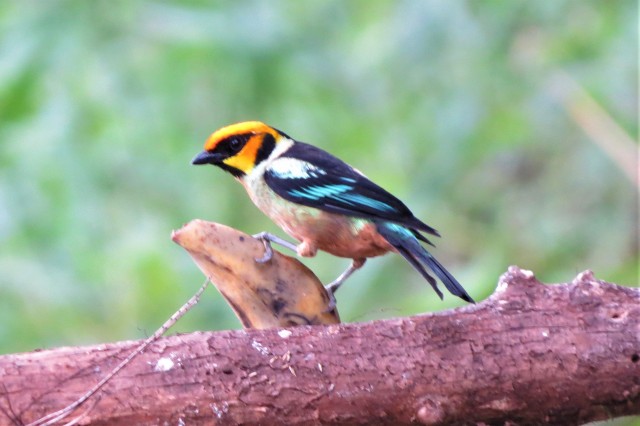
I took a trip into Mindo at lunchtime to “scope out” the town and figure out where I was going to stay after I departed Sachatamia Lodge the following day. There was a Pale-legged Hornero along the dirt road to Cinnamon House, which I took to be a good omen so I decided to stay there.
I also stopped by at El Descanso Lodge, where $4 buys you a grandstand seat overlooking lots of hummingbird and tanager feeders. It was fun to watch but I didn’t add any new birds to my list here.
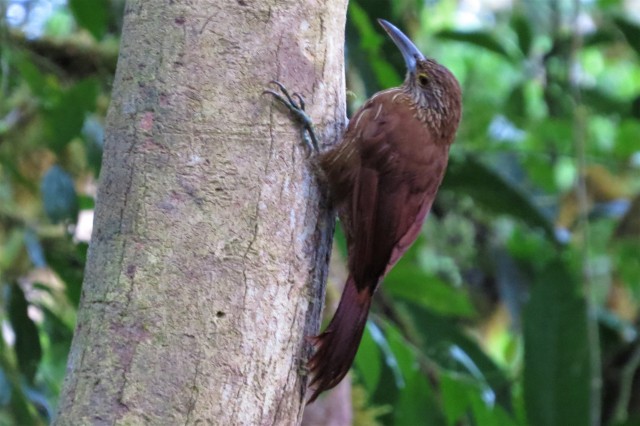
DAY THREE – Monday 23rd September: After birding at Sachatamia Lodge for the first five hours of daylight (70 species), I checked out and moved down the hill to Cinnamon House. In the afternoon, I spent a few hours on the Yellow House Trails on the outskirts of Mindo village. These trails often feature as one of the top spots to watch birds in the Mindo area – eBird shows that 397 species have been recorded there. The entrance fee is $6, but on the second day, the owner recognized me and I didn’t have to pay again.
The Yellow House Trails were far more extensive than I had been expecting, and quite a long uphill walk through suboptimal habitat is required before you even reach the trails proper. But the birds aren’t too choosy, and even on these lower stretches I encountered some great birds including Guayaquil Woodpecker, Ashy-throated Chlorospingus, and Fawn-breasted and Swallow Tanagers. Further up in the forest, the highlights included Wattled and Crested Guans, Zeledon’s Antbird, and White-winged Tanager.
Bird activity at the Yellow House Trails seemed to stay relatively high throughout the afternoon, and another excellent reason to visit this location is that it is slightly lower and was therefore sheltered – on both of my afternoon visits – from the fog and rain which covered the surrounding hills.
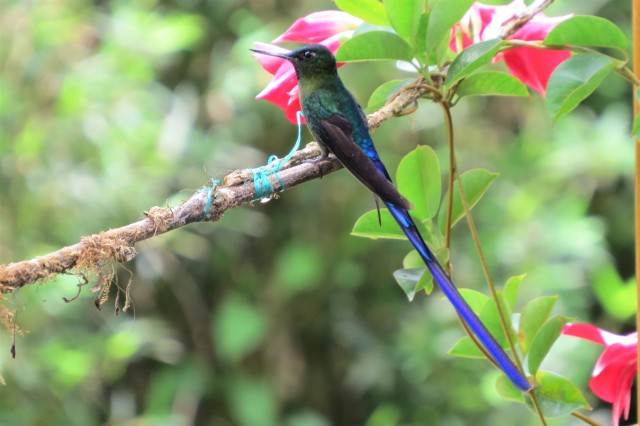
DAY FOUR – Tuesday 24th September: I had been planning to visit the Milpe Bird Sanctuary, but I awoke to persistent rain in Mindo village, which only got worse as I climbed up the hill. When I got to the turnoff for Milpe, it was pouring with rain and visibility was just a few feet. It made no sense to attempt birding in such conditions, so I made the executive decision to continue driving to Rio Silanche, which at about 500 meters (1,600 feet) above sea level, was to be the lowest altitude place on my week’s itinerary.
I was hopeful that once I had descended from the hills, the rain would stop, but unfortunately this hypothesis turned out to be false! The rain continued all day, but at least the visibility was slightly better lower down the mountain.
After turning off the main highway 28, you reach the Rio Silanche reserve by driving a rather long, and in places rough, dirt road through areas of cleared forest, agricultural land, and secondary growth. Many tour groups have their best day in this general area in terms of the number of species seen, with up to 150 species regularly recorded in a day. I later learned the day record for the Rio Silanche area is around 180 species.
Entry to the reserve costs $12; when I arrived there was no one on site to take my money, so I paid on the way out. The Rio Silanche reserve features a canopy tower, which is an exciting place to be when a large mixed flock passes through. I spent several hours on the tower, but bird activity was low in the rainy conditions today.
The rarest birds of the morning were on the drive out; a pair of Groove-billed Anis, which I photographed – this species is found in other areas of Ecuador but is a little out of range here.
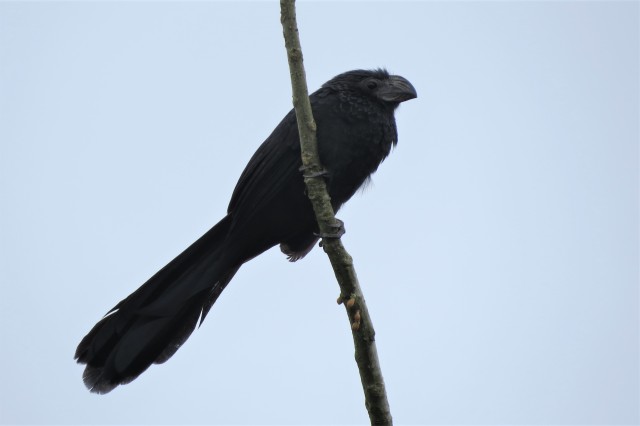
With bird activity in the Rio Silanche reserve dying off in the late morning, and the rain showing no sign of abating, I cut my losses and drove back towards Mindo, stopping at the Mirador Rio Blanco restaurant in San Miguel de los Bancos. This is a great place to enjoy a meal in a warm, dry restaurant while watching the bird feeders through the windows. It is a known location for the scarce Rufous-throated Tanager, and I saw a pair of these lovely birds on several occasions as they came to feed on the fruit put out for them.
As previously noted, the Yellow House Trails in Mindo seem to have a slightly dryer microclimate, so this is where I went for the second afternoon in a row and once again enjoyed some good birding there.
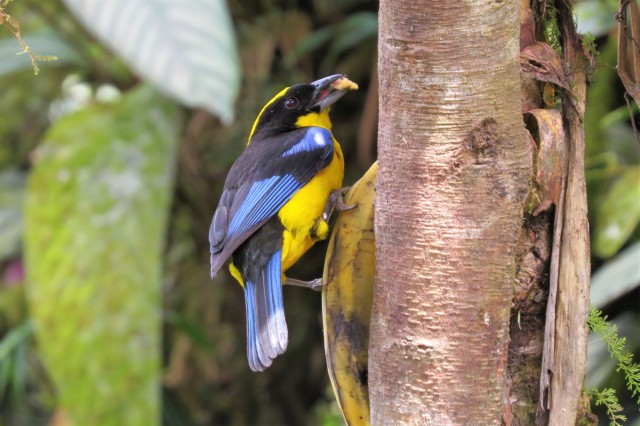
DAY FIVE – Wednesday 25th September: The story of the Refugio Paz de las Aves is famous and probably needs little introduction for those who have visited, or are considering visiting, the Mindo area. The short version of the story is that a family located on a sprawling property in the hills outside Mindo have spent many years habituating various rare and reclusive forest birds to human contact. These individuals are fed daily and over a period of many months and years become tame. A visit to this sanctuary provides the only realistic opportunity to add semi-mythical species like the Giant Antpitta to ones list.
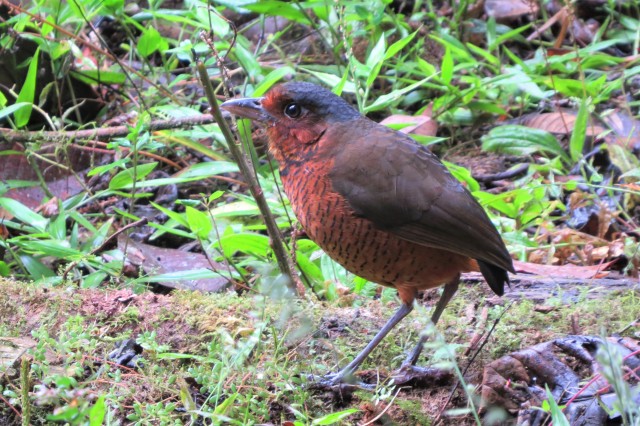
Today was probably the best day of my trip and this was largely down to luck. I had contacted the “Refugio Pas de las Aves” on WhatsApp several days prior and tried to book a tour, but had received no response. On Wednesday morning I decided to visit the refuge “on spec”. Shortly after dawn, as I neared the refuge on a dirt road, I saw a bunch of cars and tour buses parked beside the road. I spoke to a driver who indicated I should take a small side path. Turns out this was the location of an Andean Cock-of-the-rock lek! I figured I could do worse than associate with the tour groups, and so it proved, with views of Lyre-tailed Nightjar and Giant Antpitta further up the road.
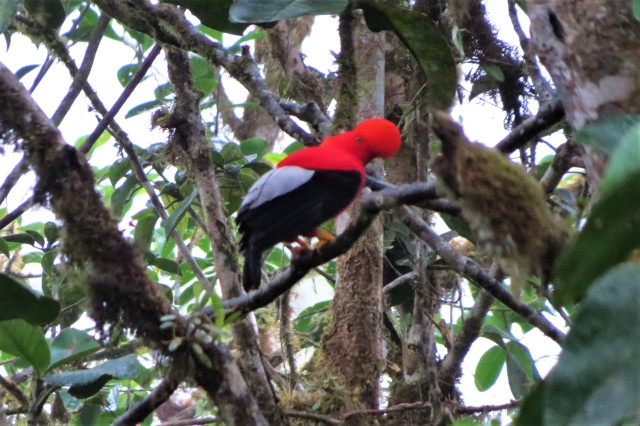
Eventually I was approached by one of the members of the refuge “family”, Angel, who asked me what I was doing there. After I had told him the story of not getting a response to my messages, he allowed me to join the tour, which included breakfast at a cost of $35. This turned out to be money well spent, with 5 Antpitta species (Giant, Moustached, Chestnut-crowned, Ochre-breasted, and Yellow-breasted) seen and photographed. The Moustached and Ochre-breasted were at the same spot, but the other antpittas were spread all over the property in different locations.
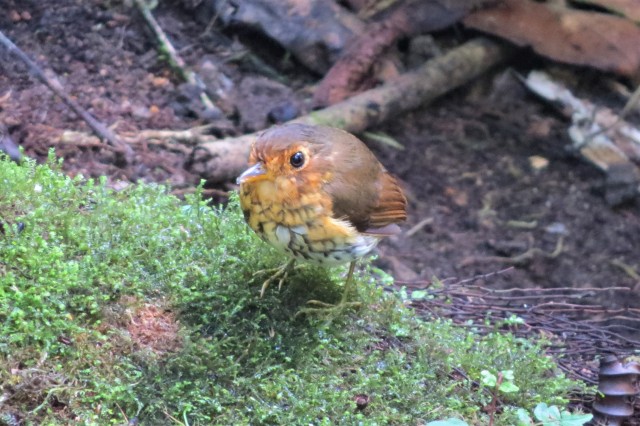
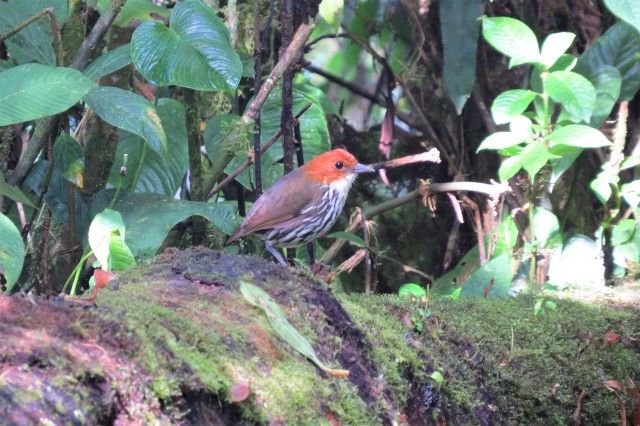
Other great birds seen during the morning tour included Powerful Woodpecker, Dark-backed Wood-quail, Choco Daggerbill, Toucan Barbet, Crimson-rumped Toucanet, Blue-capped Tanager, Golden-naped Tanager, and White-winged Brushfinch.
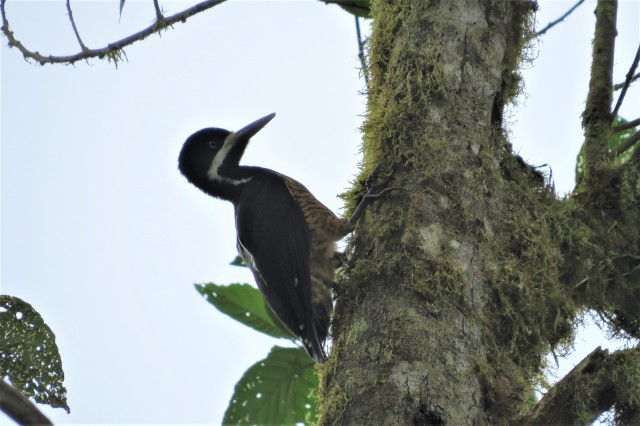
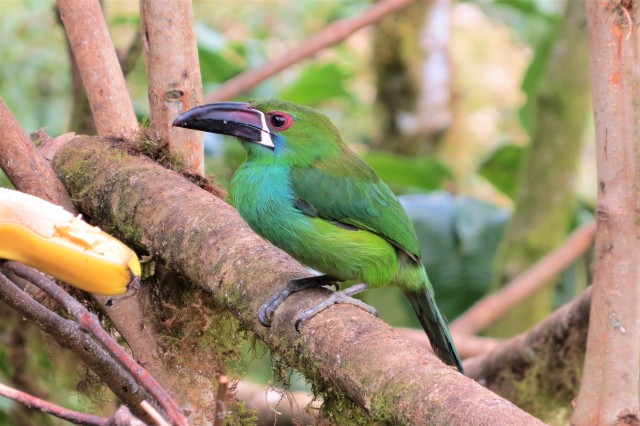
I was lucky today but you are officially not allowed to visit the Refugio Paz de las Aves without a prior reservation, and they are often fully booked, especially at the weekends. So plan more carefully than I did and make sure you reserve this wonderful tour well in advance of your planned visit.
It would be hard to beat such a successful morning, and so I had a less spectacular but still very rewarding afternoon at the Milpe Bird Sanctuary (entry cost: $12). This is one of the area’s more famous hotspots, and on this cloudy afternoon was abuzz with bird activity and big mixed flocks throughout the time I was there.
Birds I saw at Milpe which I did not encounter anywhere else included Black-and-white Becard, Spotted Nightingale-thrush, and Golden-bellied Warbler. This was the day when I finally started to feel like I was getting familiar with many of the commoner mixed-flock species.

DAY SIX – Thursday 26th September: The weather looked a lot better when I woke up, so I decided to return to Rio Silanche for a second attempt at some lower-altitude species. I had a much more successful morning today, with 89 species observed between 7.00am and 3.30pm.
Again, luck had a big part to play today – I bumped into Alex Luna, a Tropical Birding guide, and his client, whom I had met the previous day at Refugio Paz de las Aves. Today I spent a while with them on the canopy tower at the Rio Silanche reserve, and came to realize just how useful an expert local guide can be in Ecuador!
Some of the birds that Alex picked out from the tower included Violet-bellied Hummingbird, Red-rumped Woodpecker, Chestnut-fronted Macaw, One-colored Becard, Scarlet-breasted Dacnis, and both Blue-whiskered and Scarlet-browed Tanagers. Many of these birds I would have been hard-pressed to find for myself, and I suspect they would not have made it to my list if it weren’t for Alex. We also had an Olive-sided Flycatcher – a familiar bird from “back home” which turned out to be an eBird flagged rarity here!
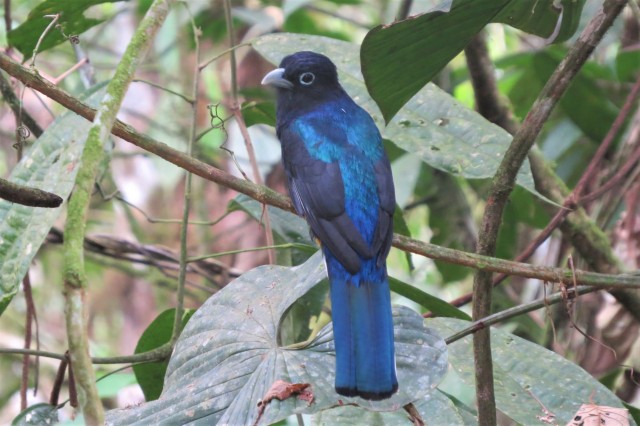

But I didn’t have absolutely everything handed to me by Alex on a plate, and I walked the loop trail alone several times and self-found some excellent birds including Little Tinamou, Rufous-fronted Wood-quail, White-bearded Manakin, multiple White-tailed Trogons, Scarlet-rumped Cacique and Dusky-faced Tanager. On the drive out, a mixed flock of seedeaters included at least one male Black-and-white Seedeater outside of its usual altitude and range.
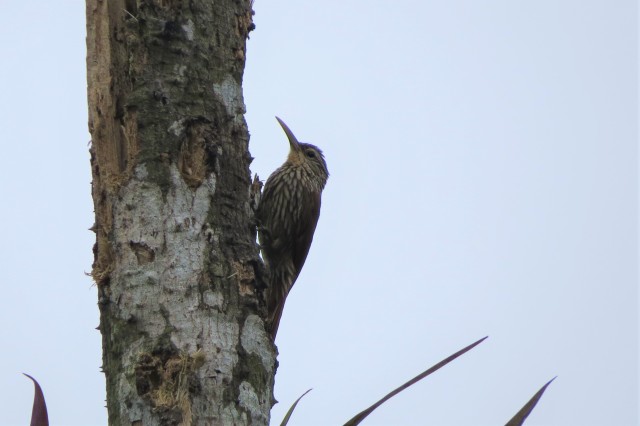
DAY SEVEN – Friday 27th September: A very early start today. I packed up my bags and departed Cinnamon House, aiming to tackle the “Eco Ruta” before it got light, and hit the Yanacocha Reserve during peak morning birding hours.
Predictably – and as is normal for Ecuador – the drive took longer than planned. After getting slightly lost just once, I found the “short cut” up to Yanacocha from the Eco Ruta – which was steep and exciting in my under-powered car – and I finally pulled into the Yanacocha Reserve parking lot just before 9.00am.
This is a reserve that would warrant several visits to get the most from the trails and the potential birds here. It is a site for the very rare and poorly known Black-breasted Puffleg, which for the casual visitor would be an outside chance at best. Bird activity was fairly high at first, but once the clouds rolled in at around 11.00am, it slowed to almost zero. I had both Rufous and Tawny Antpittas along the main trail, and the hummingbird feeders here are famous for the magnificent Sword-billed Hummingbird, which showed reliably. Black-chested Mountain-Tanager and Golden-crowned Tanager were two really excellent birds I encountered here, but in fact most of the birds were new to me, due to the extreme change in altitude compared to Mindo.
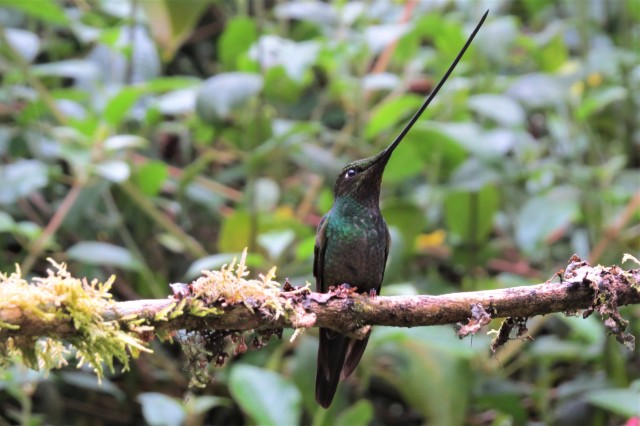
After the birding slowed, I made my way down the mountain, crossed through Quito, and continued along the excellent highway all the way to Papallacta. It was a clear afternoon, and the views across the snow-capped Andes mountains were simply breathtaking in places.
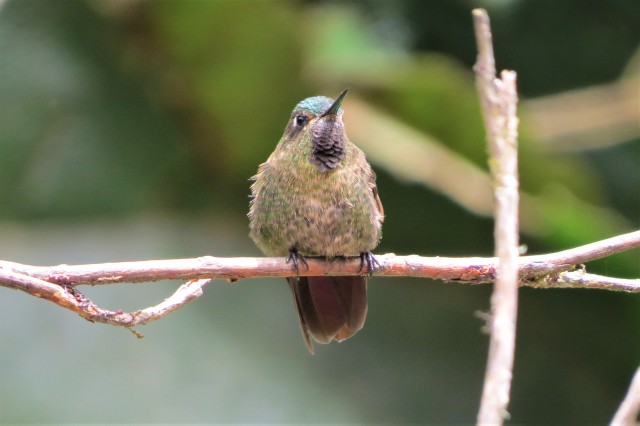
DAY EIGHT – Saturday 28th September: After spending the night at the Fogon Campero hotel in Papallacta, I awoke to a cold start, dressed in most of the clothes I had, and made my way to the top of Papallacta Pass for a stab at some of the true Andean high-altitude specialties.
The weather was chilly, foggy, and drizzly – as expected – but I still managed to see some of my target birds on my walk towards the radio antennas, including Andean Teal, Chestnut-winged Cinclodes, Andean Tit-Spinetail, and Many-striped Canastero.
By mid-morning, with the weather closing in and visibility steadily getting worse, I decided to abandon the exposed pass and drove back down to Papallacta town where I found two eBird rarities – nothing exotic, just a Bank Swallow and a Western Wood-Pewee!
Continuing lower still – and finally getting below the rain and fog – I enjoyed several hours at the well-known Guango Lodge. This is a popular spot on the bird-tour circuit, and being on the eastern slope of the Andes, has a number of different species to the Mindo area in the west. Here, I added Tourmaline Sunangel, Long-tailed Sylph, Collared Inca, Pearled Treerunner, Turquoise Jay, Mountain Cacique, and Black-eared and Black-capped Heminspingus, among others, to my list.
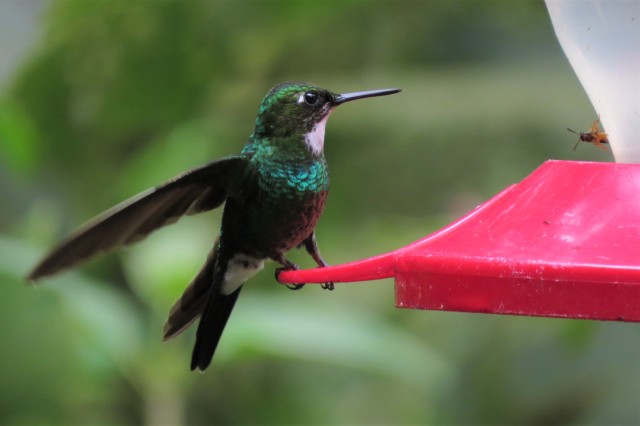
With the weather eventually lifting in the late afternoon, and the sun making an appearance, I made a final stop at Laguna Papallacta, where I was adding birds to my trip list right up to the moment I left – such is the richness of Ecuadorian birdlife.
My final night in Ecuador was spent at an airport hotel before an early flight back to Houston (via Mexico City) the following morning.
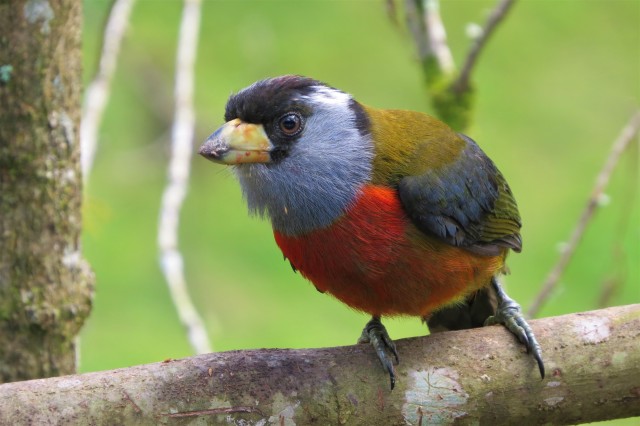
Conclusion: Ecuador is an easy-to-navigate and exciting destination for visiting birders. The independent birder will likely see considerably fewer species, in total, than the birder on a guided tour. But this should be weighed against the greater fulfillment of finding and identifying birds for yourself, instead of having them pointed out to you by tour guides.
I look forward to returning for a second visit!
Trip list:
Total species seen: 278
| # | Species | Location where first seen |
| 1 | Little Tinamou | Rio Silanche–general area |
| 2 | Yellow-billed Pintail | Laguna Papallacta |
| 3 | Andean Teal | Papallacta–radio antennas (Reserva Ecológica Cayambe-Coca) |
| 4 | Andean Guan | Reserva Yanacocha |
| 5 | Crested Guan | Mindo–Yellow House Trails |
| 6 | Wattled Guan | Mindo–Yellow House Trails |
| 7 | Rufous-fronted Wood-Quail | Rio Silanche–general area |
| 8 | Dark-backed Wood-Quail | Refugio Paz de Las Aves |
| 9 | Rock Pigeon | Mindo–pueblo y alrededores inmediatos (town and immediate surroundings) |
| 10 | Pale-vented Pigeon | Mindo–Yellow House Trails |
| 11 | Ruddy Pigeon | Rio Silanche–general area |
| 12 | Ecuadorian Ground Dove | Rio Silanche–general area |
| 13 | White-tipped Dove | Sachatamia Lodge |
| 14 | Eared Dove | Mariscal Sucre International Airport, Quito EC-Pichincha (-0.1252,-78.3602) |
| 15 | Smooth-billed Ani | Rio Silanche–general area |
| 16 | Groove-billed Ani | Rio Silanche–general area |
| 17 | Squirrel Cuckoo | Sachatamia Lodge |
| 18 | Lyre-tailed Nightjar | Refugio Paz de Las Aves |
| 19 | White-collared Swift | Sachatamia Lodge |
| 20 | Gray-rumped Swift | Rio Silanche–general area |
| 21 | Lesser Swallow-tailed Swift | Rio Silanche–general area |
| 22 | White-necked Jacobin | Alambi Cloud Forest Lodge |
| 23 | White-whiskered Hermit | Alambi Cloud Forest Lodge |
| 24 | Tawny-bellied Hermit | Sachatamia Lodge |
| 25 | Stripe-throated Hermit | Rio Silanche–general area |
| 26 | Choco Daggerbill | Refugio Paz de Las Aves |
| 27 | Brown Violetear | Alambi Cloud Forest Lodge |
| 28 | Lesser Violetear | Sachatamia Lodge |
| 29 | Sparkling Violetear | Alambi Cloud Forest Lodge |
| 30 | Purple-crowned Fairy | Rio Silanche–general area |
| 31 | Tourmaline Sunangel | Guango Lodge |
| 32 | Green Thorntail | Cinnamon House, Mindo |
| 33 | Speckled Hummingbird | Guango Lodge |
| 34 | Long-tailed Sylph | Guango Lodge |
| 35 | Violet-tailed Sylph | Sachatamia Lodge |
| 36 | Tyrian Metaltail | Nono Village Main Street |
| 37 | Glowing Puffleg | Guango Lodge |
| 38 | Sapphire-vented Puffleg | Reserva Yanacocha |
| 39 | Golden-breasted Puffleg | Reserva Yanacocha |
| 40 | Shining Sunbeam | Reserva Yanacocha |
| 41 | Brown Inca | Sachatamia Lodge |
| 42 | Collared Inca | Ecoruta–Alambi Valley (Nono-Tandayapa Road below 2500 m) |
| 43 | Buff-winged Starfrontlet | Reserva Yanacocha |
| 44 | Mountain Velvetbreast | Laguna Papallacta |
| 45 | Sword-billed Hummingbird | Reserva Yanacocha |
| 46 | Great Sapphirewing | Reserva Yanacocha |
| 47 | Buff-tailed Coronet | Refugio Paz de Las Aves |
| 48 | Chestnut-breasted Coronet | Guango Lodge |
| 49 | Velvet-purple Coronet | Sachatamia Lodge |
| 50 | Booted Racket-tail | Alambi Cloud Forest Lodge |
| 51 | Purple-bibbed Whitetip | Sachatamia Lodge |
| 52 | Fawn-breasted Brilliant | Alambi Cloud Forest Lodge |
| 53 | Green-crowned Brilliant | Alambi Cloud Forest Lodge |
| 54 | Empress Brilliant | Sachatamia Lodge |
| 55 | White-bellied Woodstar | Sachatamia Lodge |
| 56 | Purple-throated Woodstar | Alambi Cloud Forest Lodge |
| 57 | Crowned Woodnymph | Alambi Cloud Forest Lodge |
| 58 | Andean Emerald | Alambi Cloud Forest Lodge |
| 59 | Purple-chested Hummingbird | Rio Silanche–general area |
| 60 | Rufous-tailed Hummingbird | Alambi Cloud Forest Lodge |
| 61 | Violet-bellied Hummingbird | Rio Silanche–general area |
| 62 | Slate-colored Coot | Laguna Papallacta |
| 63 | Spotted Sandpiper | Guango Lodge |
| 64 | Lesser Yellowlegs | Laguna Papallacta |
| 65 | Andean Gull | Laguna Papallacta |
| 66 | Snowy Egret | Mindo–Yellow House Trails |
| 67 | Cattle Egret | Sachatamia Lodge |
| 68 | Black Vulture | Nono Village Main Street |
| 69 | Turkey Vulture | Sachatamia Lodge |
| 70 | Hook-billed Kite | Mindo–pueblo y alrededores inmediatos (town and immediate surroundings) |
| 71 | Swallow-tailed Kite | Mindo–pueblo y alrededores inmediatos (town and immediate surroundings) |
| 72 | Roadside Hawk | Rio Silanche–general area |
| 73 | Black-chested Buzzard-Eagle | Papallacta–pueblo y alrededores inmediatos (town and immediate surroundings) |
| 74 | Short-tailed Hawk | Sachatamia Lodge |
| 75 | Crested Owl | Sachatamia Lodge |
| 76 | Golden-headed Quetzal | Sachatamia Lodge |
| 77 | White-tailed Trogon | Rio Silanche–general area |
| 78 | Masked Trogon | Sachatamia Lodge |
| 79 | Rufous Motmot | Alambi Cloud Forest Lodge |
| 80 | Broad-billed Motmot | Rio Silanche–general area |
| 81 | White-whiskered Puffbird | Rio Silanche–general area |
| 82 | Orange-fronted Barbet | Rio Silanche–general area |
| 83 | Red-headed Barbet | Alambi Cloud Forest Lodge |
| 84 | Toucan Barbet | Refugio Paz de Las Aves |
| 85 | Crimson-rumped Toucanet | Refugio Paz de Las Aves |
| 86 | Collared Aracari | Sachatamia Lodge |
| 87 | Yellow-throated Toucan | Rio Silanche–general area |
| 88 | Choco Toucan | Sachatamia Lodge |
| 89 | Black-cheeked Woodpecker | Rio Silanche–general area |
| 90 | Smoky-brown Woodpecker | Mindo–Yellow House Trails |
| 91 | Red-rumped Woodpecker | Rio Silanche–general area |
| 92 | Powerful Woodpecker | Refugio Paz de Las Aves |
| 93 | Guayaquil Woodpecker | Mindo–Yellow House Trails |
| 94 | Golden-olive Woodpecker | Alambi Cloud Forest Lodge |
| 95 | Carunculated Caracara | By pass Pifo, Quito EC-Pichincha (-0.2335,-78.3266) |
| 96 | American Kestrel | Reserva Yanacocha |
| 97 | Rose-faced Parrot | Mindo–pueblo y alrededores inmediatos (town and immediate surroundings) |
| 98 | Red-billed Parrot | Mindo–Yellow House Trails |
| 99 | Blue-headed Parrot | Rio Silanche–general area |
| 100 | Bronze-winged Parrot | Mindo–pueblo y alrededores inmediatos (town and immediate surroundings) |
| 101 | Maroon-tailed Parakeet | Refugio Paz de Las Aves |
| 102 | Chestnut-fronted Macaw | Rio Silanche–general area |
| 103 | White-flanked Antwren | Rio Silanche–general area |
| 104 | Slaty Antwren | Milpe Bird Sanctuary |
| 105 | Zeledon’s Antbird | Mindo–Yellow House Trails |
| 106 | Giant Antpitta | Refugio Paz de Las Aves |
| 107 | Moustached Antpitta | Refugio Paz de Las Aves |
| 108 | Chestnut-crowned Antpitta | Refugio Paz de Las Aves |
| 109 | Yellow-breasted Antpitta | Refugio Paz de Las Aves |
| 110 | Rufous Antpitta | Reserva Yanacocha |
| 111 | Tawny Antpitta | Reserva Yanacocha |
| 112 | Ochre-breasted Antpitta | Refugio Paz de Las Aves |
| 113 | Plain-brown Woodcreeper | Sachatamia Lodge |
| 114 | Wedge-billed Woodcreeper | Milpe Bird Sanctuary |
| 115 | Strong-billed Woodcreeper | Sachatamia Lodge |
| 116 | Spotted Woodcreeper | Sachatamia Lodge |
| 117 | Streak-headed Woodcreeper | Rio Silanche–general area |
| 118 | Montane Woodcreeper | Sachatamia Lodge |
| 119 | Plain Xenops | Rio Silanche–general area |
| 120 | Pale-legged Hornero | Mindo–pueblo y alrededores inmediatos (town and immediate surroundings) |
| 121 | Chestnut-winged Cinclodes | Papallacta–radio antennas (Reserva Ecológica Cayambe-Coca) |
| 122 | Buff-fronted Foliage-gleaner | Sachatamia Lodge |
| 123 | Scaly-throated Foliage-gleaner | Sachatamia Lodge |
| 124 | Lineated Foliage-gleaner | Sachatamia Lodge |
| 125 | Streak-capped Treehunter | Refugio Paz de Las Aves |
| 126 | Striped Woodhaunter | Rio Silanche–general area |
| 127 | Pearled Treerunner | Reserva Yanacocha |
| 128 | Andean Tit-Spinetail | Papallacta–radio antennas (Reserva Ecológica Cayambe-Coca) |
| 129 | White-browed Spinetail | Reserva Yanacocha |
| 130 | Many-striped Canastero | Papallacta–radio antennas (Reserva Ecológica Cayambe-Coca) |
| 131 | White-chinned Thistletail | Papallacta–radio antennas (Reserva Ecológica Cayambe-Coca) |
| 132 | Red-faced Spinetail | Alambi Cloud Forest Lodge |
| 133 | Slaty Spinetail | Mindo–Yellow House Trails |
| 134 | White-bearded Manakin | Rio Silanche–general area |
| 135 | Club-winged Manakin | Sachatamia Lodge |
| 136 | Green-and-black Fruiteater | Refugio Paz de Las Aves |
| 137 | Andean Cock-of-the-rock | Refugio Paz de Las Aves |
| 138 | Black-crowned Tityra | Rio Silanche–general area |
| 139 | Cinnamon Becard | Mindo–Yellow House Trails |
| 140 | Black-and-white Becard | Milpe Bird Sanctuary |
| 141 | One-colored Becard | Rio Silanche–general area |
| 142 | Streak-necked Flycatcher | Mindo to Nono road – higher elevations |
| 143 | Slaty-capped Flycatcher | Mindo–Yellow House Trails |
| 144 | Scale-crested Pygmy-Tyrant | Milpe Bird Sanctuary |
| 145 | Common Tody-Flycatcher | Mindo–pueblo y alrededores inmediatos (town and immediate surroundings) |
| 146 | Black-headed Tody-Flycatcher | Rio Silanche–general area |
| 147 | Cinnamon Flycatcher | Guango Lodge |
| 148 | Ornate Flycatcher | Sachatamia Lodge |
| 149 | Brown-capped Tyrannulet | Rio Silanche–general area |
| 150 | Southern Beardless-Tyrannulet | Mindo–Yellow House Trails |
| 151 | White-tailed Tyrannulet | Sachatamia Lodge |
| 152 | White-banded Tyrannulet | Reserva Yanacocha |
| 153 | White-throated Tyrannulet | Laguna Papallacta |
| 154 | Yellow Tyrannulet | Sachatamia Lodge |
| 155 | Greenish Elaenia | Rio Silanche–general area |
| 156 | Torrent Tyrannulet | Mindo to Nono road – higher elevations |
| 157 | Choco Tyrannulet | Rio Silanche–general area |
| 158 | Flavescent Flycatcher | Sachatamia Lodge |
| 159 | Olive-sided Flycatcher | Rio Silanche–general area |
| 160 | Smoke-colored Pewee | Sachatamia Lodge |
| 161 | Western Wood-Pewee | Papallacta–pueblo y alrededores inmediatos (town and immediate surroundings) |
| 162 | Black Phoebe | Mindo–pueblo y alrededores inmediatos (town and immediate surroundings) |
| 163 | Plain-capped Ground-Tyrant | Papallacta–radio antennas (Reserva Ecológica Cayambe-Coca) |
| 164 | Masked Water-Tyrant | Mindo–pueblo y alrededores inmediatos (town and immediate surroundings) |
| 165 | Rufous-breasted Chat-Tyrant | Papallacta–pueblo y alrededores inmediatos (town and immediate surroundings) |
| 166 | Brown-backed Chat-Tyrant | Papallacta–radio antennas (Reserva Ecológica Cayambe-Coca) |
| 167 | Dusky-capped Flycatcher | Mindo–Yellow House Trails |
| 168 | Boat-billed Flycatcher | Rio Silanche–general area |
| 169 | Rusty-margined Flycatcher | Mindo–Yellow House Trails |
| 170 | Social Flycatcher | Mindo–pueblo y alrededores inmediatos (town and immediate surroundings) |
| 171 | Golden-crowned Flycatcher | Sachatamia Lodge |
| 172 | Streaked Flycatcher | Mindo–Yellow House Trails |
| 173 | Piratic Flycatcher | Rio Silanche–general area |
| 174 | Snowy-throated Kingbird | Rio Silanche–general area |
| 175 | Tropical Kingbird | Mindo–pueblo y alrededores inmediatos (town and immediate surroundings) |
| 176 | Brown-capped Vireo | Sachatamia Lodge |
| 177 | Chivi Vireo | Sachatamia Lodge |
| 178 | Turquoise Jay | Guango Lodge |
| 179 | Blue-and-white Swallow | Mariscal Sucre International Airport, Quito EC-Pichincha (-0.1252,-78.3602) |
| 180 | Brown-bellied Swallow | Reserva Yanacocha |
| 181 | Southern Rough-winged Swallow | Mindo–pueblo y alrededores inmediatos (town and immediate surroundings) |
| 182 | Gray-breasted Martin | Rio Silanche–general area |
| 183 | Bank Swallow | Papallacta–pueblo y alrededores inmediatos (town and immediate surroundings) |
| 184 | Tawny-faced Gnatwren | Rio Silanche–general area |
| 185 | House Wren | Sachatamia Lodge |
| 186 | Mountain Wren | Sachatamia Lodge |
| 187 | Sedge Wren | Papallacta–radio antennas (Reserva Ecológica Cayambe-Coca) |
| 188 | Bay Wren | Mindo–Yellow House Trails |
| 189 | Rufous Wren | Reserva Yanacocha |
| 190 | Gray-breasted Wood-Wren | Sachatamia Lodge |
| 191 | Andean Solitaire | Sachatamia Lodge |
| 192 | Spotted Nightingale-Thrush | Milpe Bird Sanctuary |
| 193 | Ecuadorian Thrush | Alambi Cloud Forest Lodge |
| 194 | Great Thrush | Nono Village Main Street |
| 195 | Glossy-black Thrush | Mindo to Nono road – higher elevations |
| 196 | Thick-billed Euphonia | Alambi Cloud Forest Lodge |
| 197 | Orange-bellied Euphonia | Sachatamia Lodge |
| 198 | Yellow-bellied Siskin | Sachatamia Lodge |
| 199 | Hooded Siskin | Papallacta–pueblo y alrededores inmediatos (town and immediate surroundings) |
| 200 | Yellow-throated Chlorospingus | Sachatamia Lodge |
| 201 | Ashy-throated Chlorospingus | Mindo–Yellow House Trails |
| 202 | Dusky Chlorospingus | Sachatamia Lodge |
| 203 | Gray-browed Brushfinch | Reserva Yanacocha |
| 204 | Orange-billed Sparrow | Rio Silanche–general area |
| 205 | Chestnut-capped Brushfinch | Sachatamia Lodge |
| 206 | Rufous-collared Sparrow | Mariscal Sucre International Airport, Quito EC-Pichincha (-0.1252,-78.3602) |
| 207 | Tricolored Brushfinch | Alambi Cloud Forest Lodge |
| 208 | Pale-naped Brushfinch | Laguna Papallacta |
| 209 | Yellow-breasted Brushfinch | Reserva Yanacocha |
| 210 | White-winged Brushfinch | Refugio Paz de Las Aves |
| 211 | Scarlet-rumped Cacique | Rio Silanche–general area |
| 212 | Mountain Cacique | Guango Lodge |
| 213 | Shiny Cowbird | Mindo–pueblo y alrededores inmediatos (town and immediate surroundings) |
| 214 | Scrub Blackbird | Sachatamia Lodge |
| 215 | Tropical Parula | Sachatamia Lodge |
| 216 | Blackburnian Warbler | Sachatamia Lodge |
| 217 | Three-striped Warbler | Sachatamia Lodge |
| 218 | Black-crested Warbler | Laguna Papallacta |
| 219 | Buff-rumped Warbler | Rio Silanche–general area |
| 220 | Golden-bellied Warbler | Milpe Bird Sanctuary |
| 221 | Russet-crowned Warbler | Mindo to Nono road – higher elevations |
| 222 | Slate-throated Redstart | Sachatamia Lodge |
| 223 | Spectacled Redstart | Reserva Yanacocha |
| 224 | Dusky-faced Tanager | Rio Silanche–general area |
| 225 | White-winged Tanager | Mindo–Yellow House Trails |
| 226 | Black-capped Hemispingus | Guango Lodge |
| 227 | Black-eared Hemispingus | Guango Lodge |
| 228 | Superciliaried Hemispingus | Reserva Yanacocha |
| 229 | Rufous-chested Tanager | Old Tandayapa Road |
| 230 | White-shouldered Tanager | Mindo–Yellow House Trails |
| 231 | Tawny-crested Tanager | Rio Silanche–general area |
| 232 | White-lined Tanager | Alambi Cloud Forest Lodge |
| 233 | Flame-rumped Tanager | Alambi Cloud Forest Lodge |
| 234 | Black-chested Mountain-Tanager | Reserva Yanacocha |
| 235 | Scarlet-bellied Mountain-Tanager | Reserva Yanacocha |
| 236 | Blue-winged Mountain-Tanager | Sachatamia Lodge |
| 237 | Golden-crowned Tanager | Reserva Yanacocha |
| 238 | Fawn-breasted Tanager | Mindo–Yellow House Trails |
| 239 | Glistening-green Tanager | Sachatamia Lodge |
| 240 | Blue-gray Tanager | Alambi Cloud Forest Lodge |
| 241 | Palm Tanager | Alambi Cloud Forest Lodge |
| 242 | Blue-capped Tanager | Refugio Paz de Las Aves |
| 243 | Rufous-throated Tanager | San Miguel de Los Bancos–Mirador Rio Blanco |
| 244 | Golden-naped Tanager | Sachatamia Lodge |
| 245 | Gray-and-gold Tanager | Rio Silanche–general area |
| 246 | Black-capped Tanager | Sachatamia Lodge |
| 247 | Scrub Tanager | Sachatamia Lodge |
| 248 | Golden-hooded Tanager | Rio Silanche–general area |
| 249 | Blue-necked Tanager | Sachatamia Lodge |
| 250 | Beryl-spangled Tanager | Sachatamia Lodge |
| 251 | Metallic-green Tanager | Sachatamia Lodge |
| 252 | Bay-headed Tanager | Mindo–Yellow House Trails |
| 253 | Flame-faced Tanager | Sachatamia Lodge |
| 254 | Blue-whiskered Tanager | Rio Silanche–general area |
| 255 | Golden Tanager | Alambi Cloud Forest Lodge |
| 256 | Silver-throated Tanager | Alambi Cloud Forest Lodge |
| 257 | Swallow Tanager | Mindo–Yellow House Trails |
| 258 | Black-faced Dacnis | Rio Silanche–general area |
| 259 | Scarlet-thighed Dacnis | Rio Silanche–general area |
| 260 | Blue Dacnis | Rio Silanche–general area |
| 261 | Scarlet-breasted Dacnis | Rio Silanche–general area |
| 262 | Green Honeycreeper | Rio Silanche–general area |
| 263 | Scarlet-browed Tanager | Rio Silanche–general area |
| 264 | Guira Tanager | Rio Silanche–general area |
| 265 | Blue-backed Conebill | Reserva Yanacocha |
| 266 | Glossy Flowerpiercer | Reserva Yanacocha |
| 267 | Black Flowerpiercer | Reserva Yanacocha |
| 268 | Masked Flowerpiercer | Old Tandayapa Road |
| 269 | Plumbeous Sierra-Finch | Papallacta–radio antennas (Reserva Ecológica Cayambe-Coca) |
| 270 | Gray-hooded Bush Tanager | Guango Lodge |
| 271 | Blue-black Grassquit | Rio Silanche–general area |
| 272 | Variable Seedeater | Alambi Cloud Forest Lodge |
| 273 | Black-and-white Seedeater | Rio Silanche–general area |
| 274 | Yellow-bellied Seedeater | Rio Silanche–general area |
| 275 | Plain-colored Seedeater | Road from San Jorge Ecolodge to Yanacocha Reserve |
| 276 | Bananaquit | Alambi Cloud Forest Lodge |
| 277 | Buff-throated Saltator | Alambi Cloud Forest Lodge |
| 278 | Black-winged Saltator | Alambi Cloud Forest Lodge |

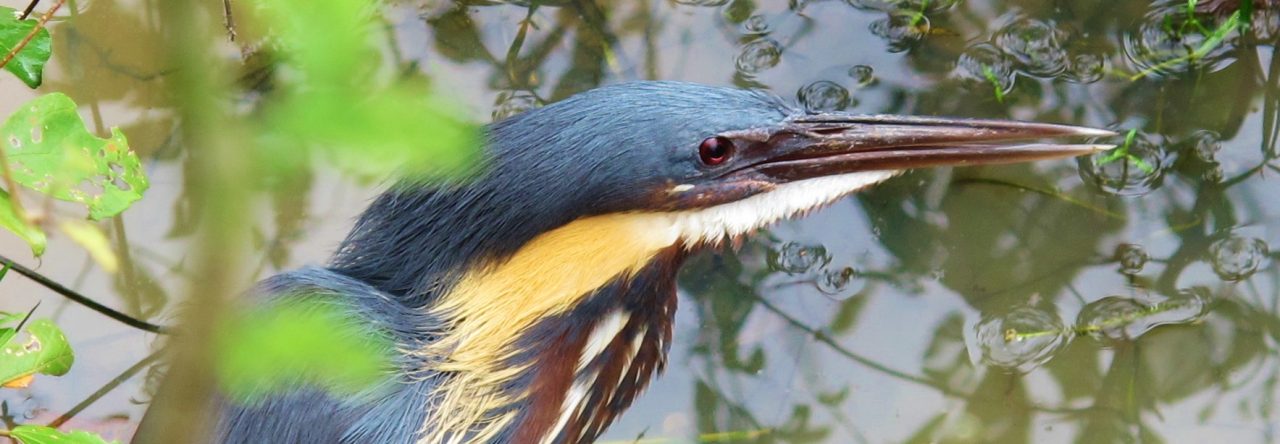
Wow! Great photos, and great information!
LikeLike
Thank you!
LikeLike
This is a great article, well written! I am doing a similar solo trip this January, starting at Papallacta and ending at Rio Silanche. A couple questions if you don’t mind…
1. What kind of outer wear do I need to stay comfortable on Papallacta? Heavy Coat? Jacket?
2. Is it worth bringing a spotting scope?
3. Do the restaurants & Gas Stations take credit cards, or is cash my best bet?
Any info is appreciated!
LikeLike
Hi Peter. Thank you for your message and I am glad you find my post useful. (1) Papallacta Pass was cold, around 5C (41F) and drizzling. I layered up with multiple thin layers (T-shirts, fleece, sweater, and waterproofs) and I was fine. I didn’t want to bring a large, heavy jacket on my trip to use on only this one morning at high altitude. (2) I didn’t bring a scope, but it would have been useful at Rio Silanche on the tower, A lot of the guides carried scopes. It would be a 50:50 decision for me, but my scope is large and bulky so I left it at home. I zoomed in on distant birds with my camera to ID them. If I had a small, compact scope I would probably bring it. (3) Some of the restaurants take credit cards, not sure about gas stations. I didn’t try and use my card much so I can’t really say how widely accepted they are. Happy to help if you have any more questions! Cheers.
LikeLike